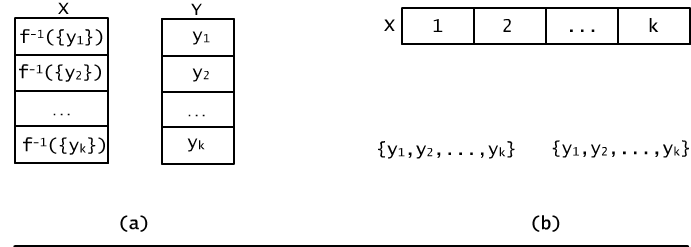
| « previous section | « next section |
Surjection is as you remember an "onto" mapping. Let's assume f to be a function from some finite set X to some set Y such that the cardinality of X is at least equal to the Y cardinality, i.e. |Y| ≤ |X|.
Notice, that if Y = {y1, y2, ..., yk} and we are given the integer function f: X → onto Y, then putting X i = f -1({yi}) for i = 1, 2, ..., k we obtain a partition of the set X into k blocks (see Figure 12.4.1(a)).
Indeed, if the sets Xi and Xj for i ≠ j have a shared element x, then, according to the definition (see lecture 3), it would be f(x) = yi as well as f(x) = yj which is impossible since f is a function. Hence for i ≠ j , the sets Xi and Xj are disjoint. Because f is a surjection, then every element of the set Y is a value for some element of the set X. Thus, all sets Xi for i = 1,2 ..., n are non-empty. Moreover, as soon as f is a total function then every element x has a value in Y. Summing up all sets X1,..., Xk, we obtain the set X.

Fig. 12.4.1 (a) Function f determines a partition of the set X. (b) Arbitrary partition of the set X into k blocks determines k! different functions onto the k-element set.
On the other hand, if we are given a partition of X into k blocks X1, ..., Xk then, ascribing them elements' of Y, we define the function from X onto Y (see Fig. 12.4.1b). For example, we can define such a function in the manner presented below:
f(x) = y1 if and only if x ∈ X1,
f(x) = y2 if and only if x ∈ X2,
...
f(x) = yk if and only if x ∈ Xk.
Because sets X1, ..., Xk are pair-disjoint, we obtain a well defined function f. The way of choosing element yi for set Xi is accidental. Truly speaking, we may use any other element of Y. Therefore, we have k! (all permutations of Y set's elements) different functions which apply to the same partition.
Because the number of partitions of an n-element set X into k blocks is equal to the Stirling's number S(n,k) we can formulate the following conclusion:
Lemma 12.4.1
There are k!*S(n,k) different surjections from the set X onto the set Y where |X| = n and |Y|= k.
Question 12.4.1 In how many ways can we split 5 different sweets between 3 children in such a way that each of them gets at least one sweet?
| « previous section | « next section |